Pros and Cons of a Standing AC Unit
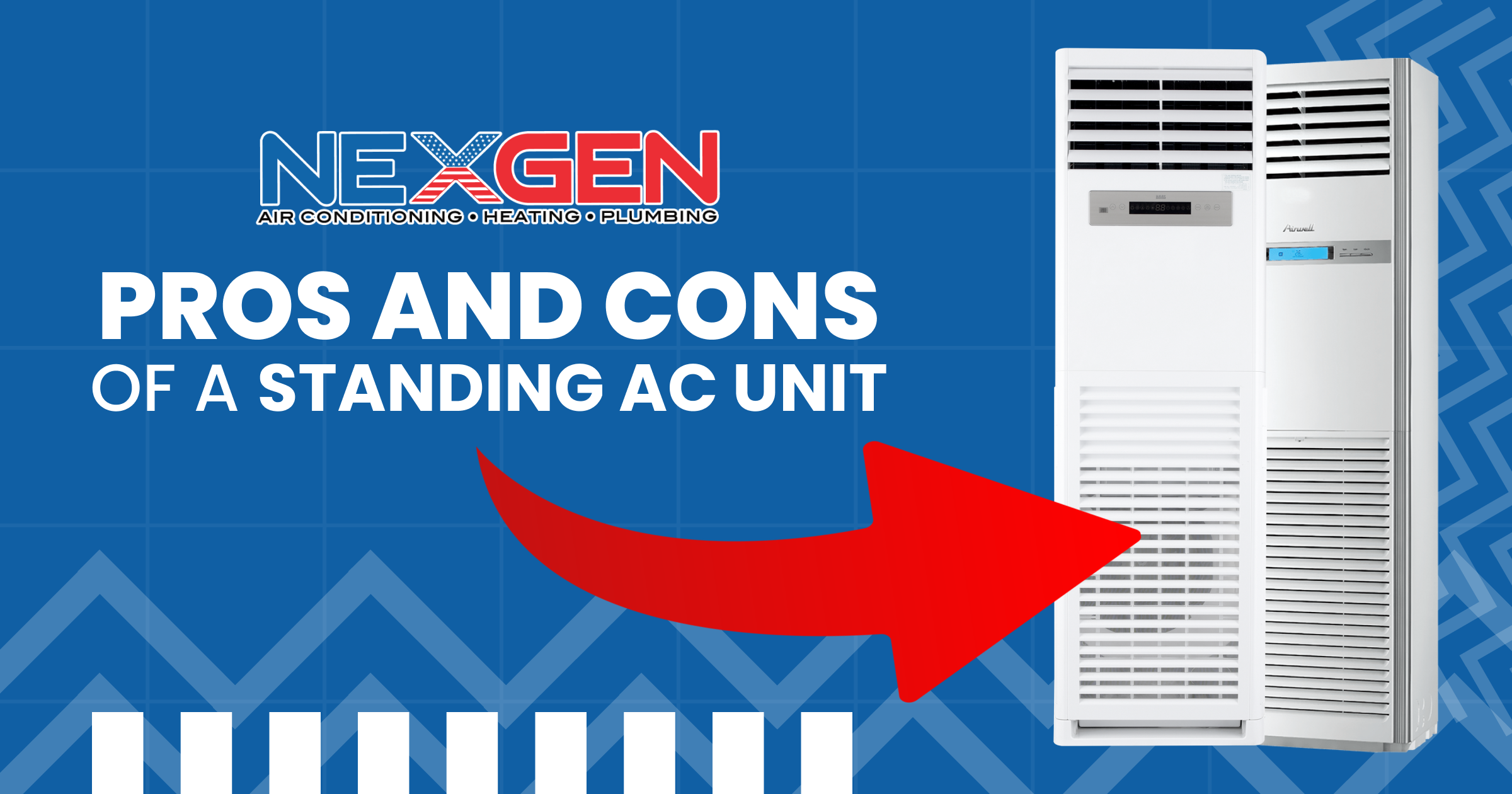
Without a large central AC system, parts of your home may be too hot in summer. Nonetheless, adequate cooling for every room is still possible. A standing AC unit is a convenient option. We will explain the pros and cons of a portable air conditioner, which works similarly to a central air conditioner.
How Does a Portable Air Conditioner Work?
A standing air conditioner can be useful whether you don’t have central AC or it does not serve a particular room. The unit operates on a smaller scale. It draws air from outside through a window, cycles it through a compressor, blows cool air inside, and exhausts hot air outside. All the unit’s working components are contained in a single housing, including coiled tubes that circulate refrigerant. A pipe or air duct allows for an exchange between outdoor and indoor air.
Pros of a Standing AC Unit
The benefits of using a portable AC include:
- Mobility: The unit can be moved from room to room as needed. For example, you can place it in your living room or home office during the day and move it to the bedroom later. Some standing AC units have casters on the bottom, so can be wheeled to a new location. You can even pack one in a car and use it when traveling.
- Easy to Install: The AC unit is ready to use as soon as you bring it home. Its instructions should explain how to connect and assemble the window hose. Vent hoses are usually 5 feet long or less, so units must be installed close to windows. A window bracket, vent hose adapters, and one or two hoses are typically included.
- Suited for Small Spaces: If the particular space you want to cool is small, an oversized AC won’t provide many benefits. Standalone portable ACs are best for 100- to 300-square-foot rooms where spot-cooling is most effective.
- Preserves Access to Windows: The intake/exhaust hose requires a small space. But access to most of the window is preserved. A standing AC unit also does not block natural light, reducing the need for artificial lighting.
- Convenience: Apartment buildings and homeowners associations don’t always allow window air conditioners. A standing unit can be used instead. Many standing models also provide heat. Connecting a portable unit to a programmable thermostat adds even more convenience. Battery-powered units are an alternative when there’s limited access to electrical power.
- Low Cost: Portable air conditioners cost less than central AC units, especially considering the cost of equipment and labor. A portable unit’s compact size and small capacity means it’s also affordable to operate. It can help manage your utility bills.
- Can Also Control Humidity: High humidity in your home can cause wood furnishings to rot, walls to be damaged, and mold and bacteria to spread. A standing AC unit often has a built-in dehumidification function that may work even when cooling isn’t needed.
Cons of a Standing AC Unit
Despite their many benefits, stand-alone AC units have disadvantages worth considering. These can include:
- Not Always Efficient: Compared to window ACs, portable devices require more British Thermal Units (BTUs) to cool the same square footage. Waste heat may be blown indoors, so the unit must handle that too, requiring more electricity.
- Noise Level: All the parts are working within the portable unit while you’re eating or trying to watch TV. You can lower the fan speed or place the unit in a distant corner to reduce the noise.
- Moving It May Be a Hassle: Connecting and setting up the vent line can take time. While the unit’s mobility is a pro, having to redo the installation and get it right may not feel like a great investment in time.
- Difficult to Repair: If a standing AC unit breaks, its design makes it difficult to repair. All the components are tightly sealed in a compact device. Damaged or malfunctioning portable ACs are usually replaced.
Contact NexGen Today
NexGen provides a wide range of high-quality HVAC equipment. We’ll help you determine the best system for your Southern California home or business. Traditional, electric, rooftop, and ductless systems are available and we specialize in the latest air purification equipment and thermostats. Our licensed contractors can help install, repair, and maintain your heating and cooling system. For assistance from licensed, insured technicians, book your visit online or call (833) 729-9735.
Are Air Conditioning Repairs Worth It?

If your aging air conditioner is acting up, a technician may weigh whether to repair or replace it. Air conditioning repairs can have many benefits. They can restore cooling performance, improve efficiency, and extend the lifespan of your AC. But to decide if more repairs are worth it, consider the following:
Cost of the Repair
Different formulas help determine if an AC repair is worth it. Some experts say to move forward with repairs if the estimate is less than 50% of the cost of replacement. If the estimate is close, don’t be afraid to get a second opinion. Another method is to multiply the age of the unit by the repair cost; replace the AC if the total exceeds $5,000. Multiple repairs in one year can strain your budget. However, if the system only needs occasional repair, it’s worth it.
Age of the System
The age of your AC unit is a major factor in deciding whether to repair or replace it. According to the U.S. Department of Energy, a central air conditioner has a lifespan of 15 to 20 years.¹ In harsher climates, it may last only 10 to 12 years. But AC longevity is affected by many factors, including quality of installation and how well it’s been maintained. If it’s over 10 years old and needs major repairs, consider whether replacement is more affordable.
Have You Kept Up with Maintenance?
Annual maintenance and tune-ups can prevent many AC problems. Just by changing the filter every 1 to 3 months, keeping plants and debris away from the outdoor unit, and scheduling minor repairs when necessary, your system can last longer. But if you’ve neglected maintenance, multiple problems may be too expensive to fix.
Efficiency
An air conditioner’s energy efficiency has a significant impact on operating costs. In the Southern U.S., all new ACs must be rated at least 15 SEER (as of January 2023), so having a unit with a 14 to 25 SEER rating aligns with current standards. That means your 12 SEER unit that’s 15 years old costs you more money than necessary (also, consider that operating efficiency declines with age). That means upgrading to a newer, more efficient unit will reduce energy costs.
The AC Still Runs on R-22 Freon
With the phase-out of R-22, Freon and the systems that run on it are becoming scarcer. Recharging an R-22 system is becoming prohibitively expensive. So is finding replacement parts for one. Therefore, you’re likely better off replacing the system with one that uses R-410A refrigerant, a more environmentally friendly option that can’t be used in older units.
Components Are Matched/Mismatched
If an outdoor or indoor unit was once replaced separately, the system may have kept working. But an equipment mismatch can shorten its lifespan. At the very least, it will reduce efficiency. Replacing your HVAC with a matched system will improve efficiency and have a wide range of other benefits for years to come.
Your Home’s Comfort Level
Think about how comfortable you were before needing an air conditioning repair. Has your home not been cool enough? Have you noticed hot and cool spots at home? Are there humidity issues or are your energy bills getting more expensive? If you’ve answered yes to any of these questions, it’s time to consider replacing the system or updating it to one that supports variable speed technology or zoning.
Energy Efficiency Incentives
Even if you could afford another AC repair, what if rebates, tax credits, or other financial incentives can save you more? Manufacturers, utility companies, and local government agencies across the U.S. offer financial incentives for installing high-efficiency equipment. The amount you can save on an air conditioner varies from company to company and region to region. You may save a few hundred or thousands of dollars by replacing your AC.
Are Air Conditioner Repairs Worth It to You?
Whether you base your decision on cost calculations or how your AC is performing, the decision to repair or replace it comes down to your unique situation (unless the system has completely failed). We believe in providing the knowledge to make informed decisions. Air conditioner repairs are worth it for a younger, well-maintained system. But they get more costly as a unit ages along with the overall cost of ownership.
NexGen Will Repair or Replace Your AC
Our experienced technicians provide air conditioning repair services in Southern California. They’re able to fix common issues and ensure your system is more efficient and reliable. But we know sometimes AC repair is not enough. If you’ve had numerous air conditioner repairs and your AC is nearing 20 years old, let’s talk about replacing it. We’re ready to evaluate your system and answer your questions. To get started, call (833) 729-9735 today.
Source:
1. https://nexgenairandplumbing.com/air-conditioning-repairs-and-replacements/
What Does an AC Tune-Up Cost?
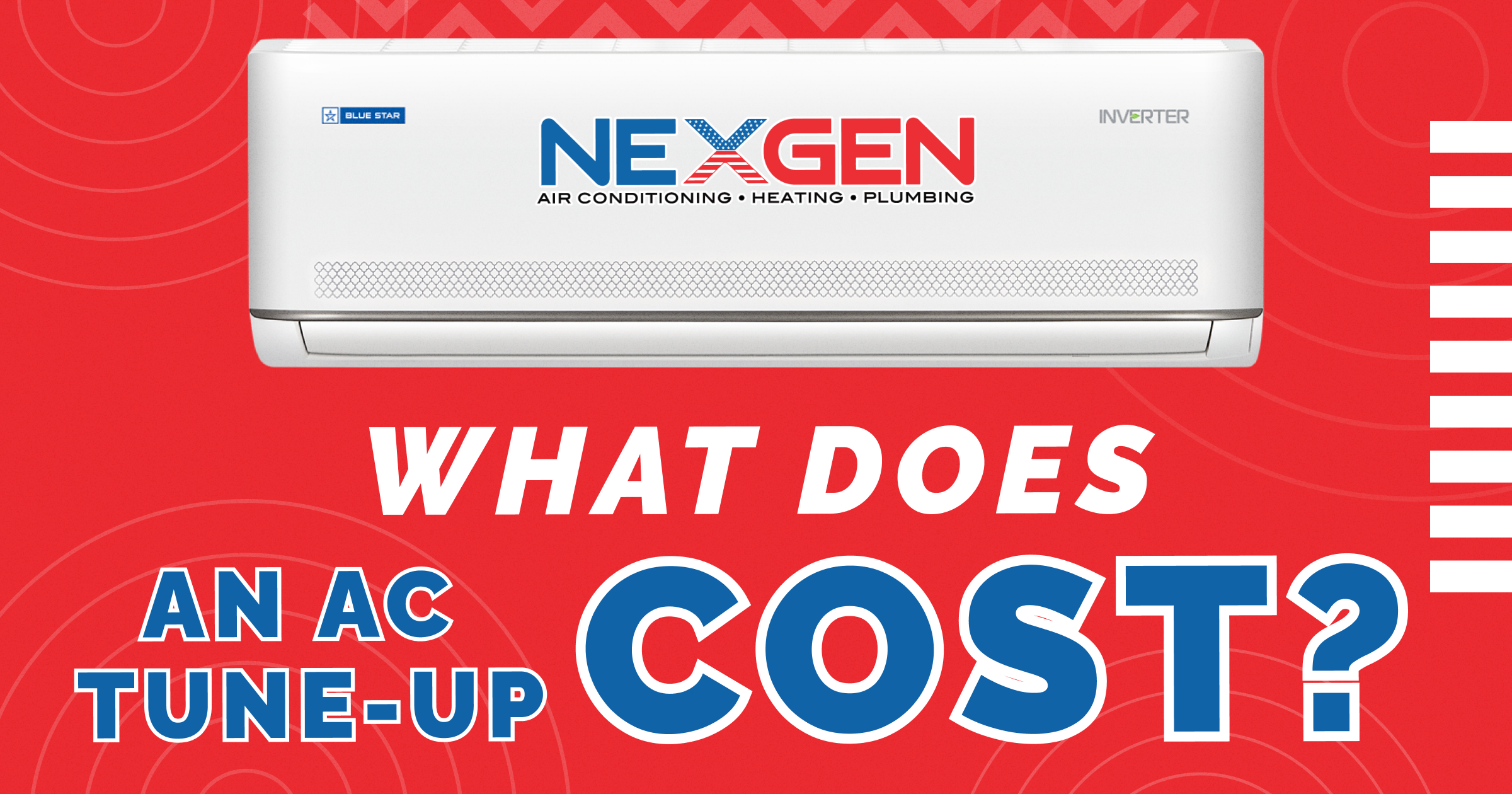
An AC tune-up includes the maintenance needed to improve comfort, reliability, and efficiency. Tune-ups can also help avoid expensive repairs. However, they don’t come cheap. Homeowners often wonder how much the service will cost them. The price depends on the scope of the service and where you live. Let’s look at the possible cost of an AC tune-up.
The Average Cost of an AC Tune-Up
According to Forbes, a tune-up can cost anywhere from $30 to $300. On average, it costs around $120 to tune up your air conditioner.¹ That’s a small price compared to repairs that can cost thousands of dollars. A tune-up can even help your AC last longer, delaying the need to pay for a replacement unit.
Factors that Affect the AC Tune-Up Cost
Not every tune-up is the same just as not every air conditioner is the same. The cost of tuning up an AC depends on the following:
- AC Unit Size: The larger the AC unit, the more it will cost to service. You might pay as little as $50 to have a window or small unit tuned up. A large system may cost $350 to $750 to service.¹
- Type of Service: A tune-up can involve just a few adjustments or more significant repairs. A simple tune-up can cost under $200. Replacing a filter will cost under $50, but recharging AC freon can cost $600 or more depending on the issue and your system. It can cost up to $300 just to check for a leak.¹
- Air Conditioner Age: Older ACs are more likely to need big repairs. It’s also more difficult to find replacement parts for them. Scarcity drives up prices. Simpler fixes can be costlier, too, especially if your AC is over 15 years old.
- Local Climate: The more you run your air conditioner, the more wear and tear will occur. If you live in a warm climate like Florida, Texas, or Arizona, your AC may need a heavier tune-up than one in a home farther north.
- How You Care For It: Running the unit for longer than necessary or turning the temperature up or down more than needed can strain your HVAC system. Blocking air vents can decrease efficiency. A lack of proper care may lead to a more extensive tune-up and higher service costs.
Also, note that inspections of your ductwork and ventilation system will cost extra. According to Angi, this can run between $80 and $450.²
Can I Perform an AC Tune-Up Myself?
You won’t save on performing an AC tune-up yourself. Aside from changing the filter and doing simple cleanings, attempting to replace a fan motor, repair a refrigerant leak, or complete any other type of major repair can result in more damage and void the warranty.
When Should I Get an AC Tune-Up?
An annual tune-up should be completed in the spring. It will ensure your AC works all summer and can save on energy bills. Schedule additional maintenance throughout the year if your air conditioner is older or has known issues.
How Long Does It Take?
A standard tune-up takes about an hour if the system doesn’t need any significant repairs.
What’s Included in an AC Tune-Up?
Most HVAC contractors include tune-ups in their maintenance packages. They often include air filter replacements and inspections of fan motors, capacitors, and ducts. A technician will also check the thermostat and electrical controls. Checking refrigerant levels helps determine if there is a leak. If necessary, the drainage system is inspected and flushed.
Contact NexGen for AC Maintenance
NexGen provides high-quality air conditioning maintenance in Southern California. When it’s time for your annual AC tune-up, you can count on our licensed technicians to ensure your unit is reliable and efficient. Tune-ups help prevent breakdowns, but we’re available 24/7 to help in emergencies. To ensure your AC maintenance needs are met, schedule a tune-up today by calling (833) 729-9735.
Sources:
- https://www.forbes.com/home-improvement/hvac/ac-tune-up-cost/
- https://www.angi.com/articles/ac-service-cost.htm
What Do AC Installation Services Include?
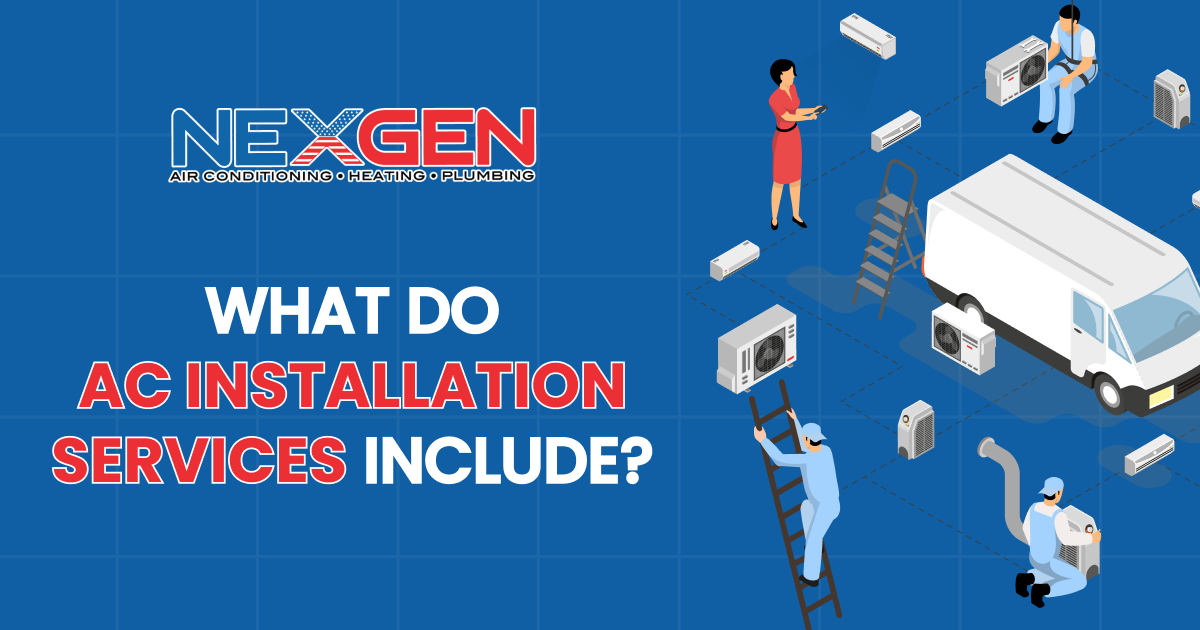
According to Angi, installing a new AC unit can cost up to $8,000(based on 2023 data). But installation doesn’t only include connecting and setting up a unit. There are several steps and tasks homeowners often aren’t aware of. This article will explain the process a trained HVAC technician will follow when providing AC installation service.
Home Evaluation and System Planning
An AC installer will first inspect your home to identify your needs. Are you replacing an existing unit or relocating your HVAC system? Many newer air conditioners are larger in dimensional size, so the current location of your AC may be unsuitable. Manufacturer guidelines, state laws, and local regulations may dictate equipment placement, clearance, and distance from utility meters.
Plus, the installer will consider your climate and the typical levels of heat and humidity. They’ll also perform an energy audit to look for poor insulation, drafty windows, and other factors that can reduce efficiency. Recommendations on improvements often target ways to maximize an AC’s energy efficiency over time.
A Load Calculation
The size (capacity) of an HVAC system must be just right. A technician will determine the square footage of your home and consider other factors to identify the cooling power you need. Many people oversize their air conditioners, lowering efficiency and increasing wear and tear. While sizing an AC unit requires extra time, it can pay off in improved comfort, moisture removal, energy efficiency, and fewer repairs.
A Discussion of High-Efficiency Options
A reputable contractor will explain options that can provide more efficient cooling. If your AC is well-maintained, it can last 15 to 20 years. During that time, you can save significantly if the system is efficient. Air conditioner efficiencies are rated using the following:
- Seasonal Energy Efficiency Ratio (SEER): Measures how much energy an AC unit uses over a year. The higher the SEER number, the more energy efficient the unit is.
- Energy Efficiency Ratio (EER): A room air conditioner’s ratio of cooling capacity in British Thermal Units (BTUs) per hour to its output in watts.
- Heating Seasonal Performance Factor (HSPF): Used to measure heat pump efficiency, HSPF is the ratio of heat output over the season to the electricity the system uses.
Inspect the Ductwork
During an AC installation service call is a good time to evaluate ductwork for issues that decrease efficiency. Some considerations include whether the duct system is compatible with or large enough for the new unit. An inspector will also determine if your ductwork needs to be sealed or repaired. If there’s significant dirt and dust buildup, air ducts will be cleaned as well.
The Team Arrives and Prepares for the Installation
The installation crew should call or text their expected arrival time. You’ll speak to the lead installer about the project, the equipment to be installed, and other details. Good communication avoids misunderstandings and costly mistakes. In preparation for your new system, the installers will turn off the electricity and gas supply to your existing HVAC equipment and add protection to floors and furniture. All the tools and equipment they’ll use will be set up.
Your Existing AC Is Removed
The refrigerant will be safely recovered and discarded with special machinery. A technician who removes AC refrigerant must be EPA certified to do so. Next, electrical wiring is disconnected from the unit, and then the disconnect box and electric power conduit are replaced. The old condenser unit and indoor evaporator coil, air handler, and copper refrigerant line are carefully removed to make way for new equipment. If necessary, modifications to the plenum will be made.
The Area Is Prepared
The pad the outdoor unit sits on is replaced and leveled. The ground below it may need to be leveled too, either by laying a gravel base or pouring a concrete pad. Composite pads are often used as concrete is prone to cracking and shifting and not as resistant to machine vibrations. Thorough preparation is necessary because, after installation, air conditioners can’t be moved or lifted without causing serious damage.
The New AC System Is Installed
The installation procedure depends on the exact type of air conditioner. The general process during AC installation service is as follows:
- The indoor evaporator coil or indoor unit is mounted
- The drain pan is set above the furnace
- The copper refrigerant line set (suction line and liquid line) is installed
- The condenser is unpacked, set on the pad, and wired to the electrical disconnect
- The line set is fitted to the air conditioner’s service valve and welded in place
- The liquid line filter drier is installed near the expansion valve
- High- and low-voltage wiring is connected to the electrical panel
- The condensate drain line is set up
If installing a mini-split system, ductwork installation or modification will be skipped. The installation crew will drill one hole in an exterior wall to connect a conduit between the outdoor and indoor units.
Contact NexGen to Schedule High-Quality AC Installation Services
NexGen is a leading AC installation services provider in Southern California. We take every possible measure to install an air conditioner correctly. Our employees are licensed, trained, and background checked, as well as honest and reliable. If it’s time to replace your AC, we’ll ensure your new unit operates efficiently with no safety or health hazards.
NexGen will also help determine the right type and size of unit for your home. All components, including thermostats, will be set up for you and our team will manage insulation and other requirements. To schedule AC installation and learn about our maintenance plans and warranties, contact us online or call 833-729-9735.
How Do Portable Air Conditioners Work?
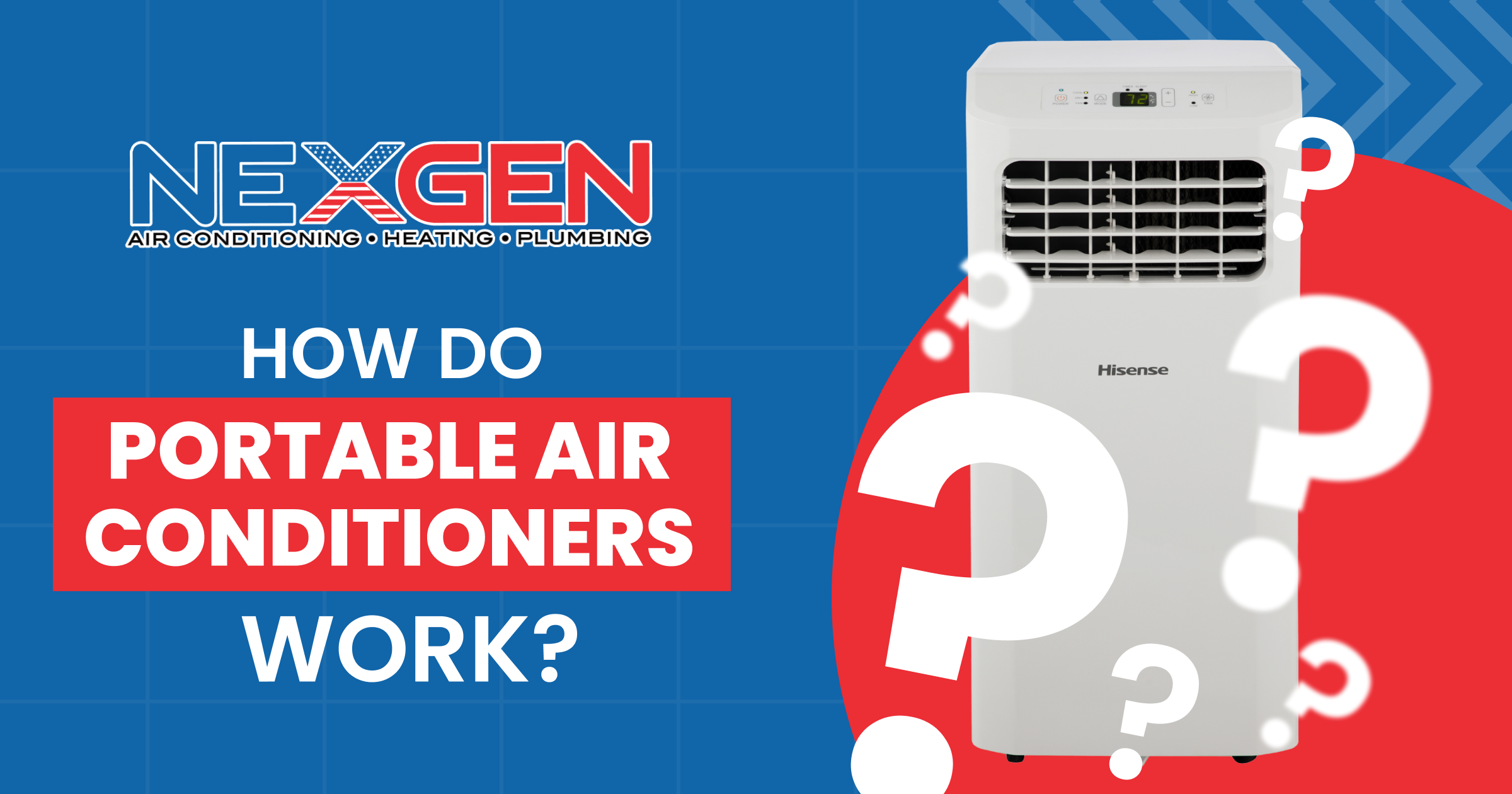
If you’re looking to cool a room or small space, a portable air conditioner can do the job. It effectively cools the air, circulates it, and removes excess humidity. We’ll now answer the question, “How do portable air conditioners work?” in more detail to help you decide on whether to install one.
How a Portable Air Conditioner Works
A portable AC is typically a single freestanding unit with wheels or casters at the bottom. It has a fan that pulls in hot, humid air from the room. Inside the unit, heat is transferred to refrigerant running through the condenser coils. At the same time, water vapor condenses on the coils, removing humidity. The refrigerant turns into a high-pressure gas that eventually releases the heat that’s absorbed from the air.
Moisture that is collected by the system is removed by emptying an internal water reservoir. But many portable air conditioners have an exhaust hose that vents moisture and heat outside. Depending on the model, it may require a separate window venting kit, or it may direct exhaust through an existing air duct.
Portable Air Conditioner Features
Some portable ACs use a single hose that removes warm air and moisture. Others have a dual-hose configuration; one hose pulls in fresh air from outside (to cool the compressor and condenser coils) and the second hose pulls excess warm air and moisture from the unit and releases it outside. A dual-hose unit can often cool a room more quickly without creating negative pressure.
Depending on the model, a portable air conditioner can be remotely controlled, operate in fan mode only, or cool a room to a set temperature. Units with a timer can start or stop depending on the time of day. Other products can dehumidify the air without being set to cool, while others move side to side to help distribute cool air.
Installing a Portable Air Conditioner
The installation requirements will vary depending on the model you purchase. Most units are easy to set up. Just remember to consider the following requirements:
- Free space to place and set up the portable air conditioner.
- A space at a window or other opening to attach the exhaust hose.
- A 120-volt power outlet (unless the unit is rated at 14,000 BTUs or more).
How to Use a Portable Air Conditioner
Portable AC units are designed to be vented out a window. This is how portable air conditioners work. Hot air must be vented somewhere; if that’s not a window, a hose can be directed up a chimney or through a hole in the wall. However, it’s not recommended to change the length of the hose, as it’s designed specifically for that machine (doing so can overheat the unit or void the warranty). If you must run the hose through a sliding glass door, purchase an extension kit suited for the model and use styrofoam or plywood to fill the void around the hose.
The drainage method depends on the unit. If you have a self-evaporative, portable AC, moisture will evaporate out of the exhaust hose. Some systems have a gravity drain that eliminates water that’s pulled down and out of the unit by gravity. A condensate pump can be used to collect water so you can dispose of it. If your portable unit has a collection tank, it will collect moisture inside. To empty it, turn off the AC, remove the collection bucket, and empty it before placing it back in the unit.
Portable AC Maintenance Tips
Maintaining a portable AC is simple and can help it work better and last longer. First, unplug the unit to eliminate any shock or fire hazards. Then follow these tips to care for your portable cooling system:
- Clean the filter every two weeks, using warm water and a mild dishwashing detergent, and let it air dry before placing it back inside.
- Wipe the exterior of the AC with a damp, lint-free cloth and mild dishwashing soap.
- Wipe off the air vent grille to eliminate trapped particles and avoid blocked airflow.
- Empty the water collection system weekly to prevent overflow and mold growth (if the unit doesn’t self-evaporate).
- When storing the unit, do so in a cool, dry location; keep it covered or stored in the packaging it came with.
Are You Ready to See How a Portable Air Conditioner Works?
A portable air conditioner can be a convenient and effective way to stay cool, depending on your needs. It’ll cool a room and vent heat and moisture out a window when properly installed and maintained. However, it’s just one of many options for cooling a home or office. NexGen provides professional air conditioning services in Southern California and high-quality central, window, and packaged units as well as ductless mini-split equipment and heat pumps.
Our licensed technicians help install, repair and maintain all system components. They can also provide advice on the right type and size of the system for you. Our team will fully explain all your options. If you have additional questions or want to schedule service, call NexGen at 833-729-9735 today.
Why Is My Mini-Split Freezing Up in Heat Mode?
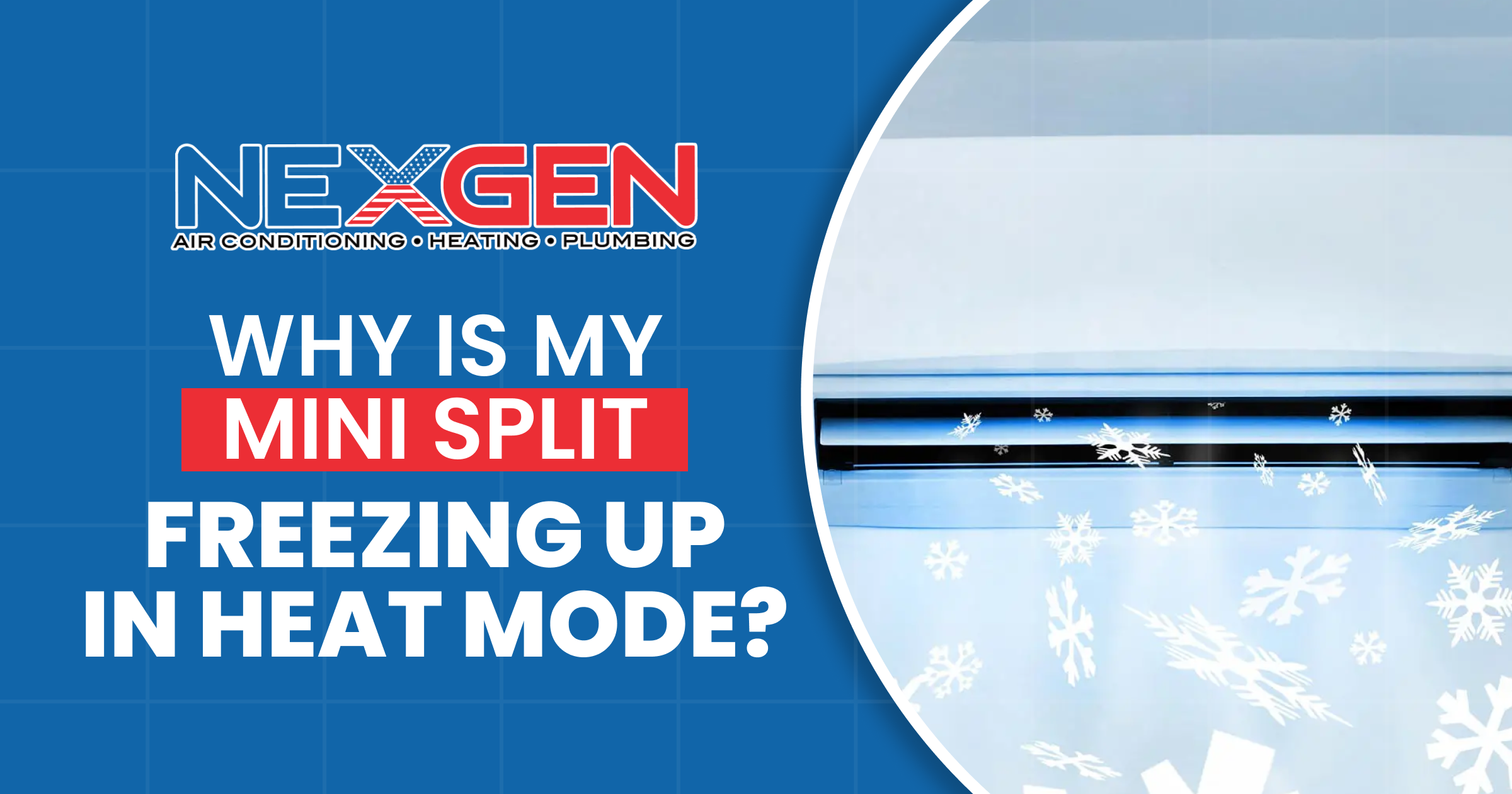
Mini-splits work hard throughout the year. They work even harder when the outdoor temperature drops below freezing. If the increase in wear and tear isn’t enough, mini-split units are prone to freezing in winter and being damaged by ice. The occasional icicle on the outdoor unit isn’t a concern. But you may wonder why your mini-split is freezing up in heat mode.
To explain why this happens, let's look at how a heat pump works. It does not generate heat of its own. Instead, it moves heat, transferring it from the outside air to your home. As the refrigerant moves through a closed-loop system, heat is pulled from the air and the temperature around the heat pump drops, sometimes low enough for condensation to form on the coil. In extreme cold, this condensation will freeze.
Your Ductless Mini-Split Has Built-In Protection Against Ice
Colder temperatures are bound to affect your mini-split system, but a defrost mode protects it. It is controlled by an internal thermostat that triggers a defrost cycle when the unit’s temperature drops below a certain threshold. The unit then automatically switches to cooling mode to increase the temperature of the outdoor coil. Once the ice melts and the internal thermostat senses the coil is warmer, the system will automatically switch back to a heating cycle.
But if the unit keeps freezing up or doesn’t defrost properly, the following issues may be the cause:
- Faulty wiring
- Poorly installed fan
- Malfunctioning thermostat
- Refrigerant leak
- Stuck reversing valve
- Outdoor coil damage
An issue with air circulation can make your mini-split more prone to freezing. Unless air moves constantly over the evaporator coil, cold air will remain above it and freeze any condensation that forms. A dirty filter can also restrict airflow enough to cause freezing. Dirt on the coil can lead to frost and ice too. So, anything that blocks air movement is a potential contributor to a mini-split freezing up in heat mode.
Can I Unfreeze a Mini-Split Myself?
If the unit isn’t defrosting effectively, turn it off and disconnect it from its power source. The ice may then melt on its own. Or, if necessary, you can gently remove the ice and wipe the coils with a dry cloth. Completely dry the system before powering and restarting it. Even though it may start working, it’s important to address the cause of the problem, whether by changing the filter, having the coils cleaned, or having the refrigerant level filled.
How Do I Stop My Mini-Split from Freezing Up?
Regular maintenance and calling a technician when you suspect a problem can prevent ice from forming. Routine inspections let contractors find small issues that can lead to freezing, so your ductless mini-split will operate normally. However, there are steps you should take to avoid a frozen unit. You don’t need a professional to:
- Turn on the defrost setting at the condenser controls.
- Check the unit daily for ice and take the appropriate actions.
- Cover the mini-split to prevent contact with the snow.
- Elevate the unit (about two feet) so it doesn’t suck in snow and ice.
- Brush off any snow that falls on the outdoor condenser.
Call NexGen If Your Mini-Split Freezes Up in Heat Mode
If your mini-split keeps freezing up while providing heat, it may need to be repaired. NexGen provides reliable ductless heating and cooling system repair no matter what the issue is. We specialize in servicing high-efficiency equipment so it works more effectively and lasts longer. When your mini-split is freezing up in heat mode, it’s susceptible to damage, so call NexGen at 833-729-9735 to schedule immediate repairs.
Are There Combination Heating and Air Conditioning Units for Apartments?
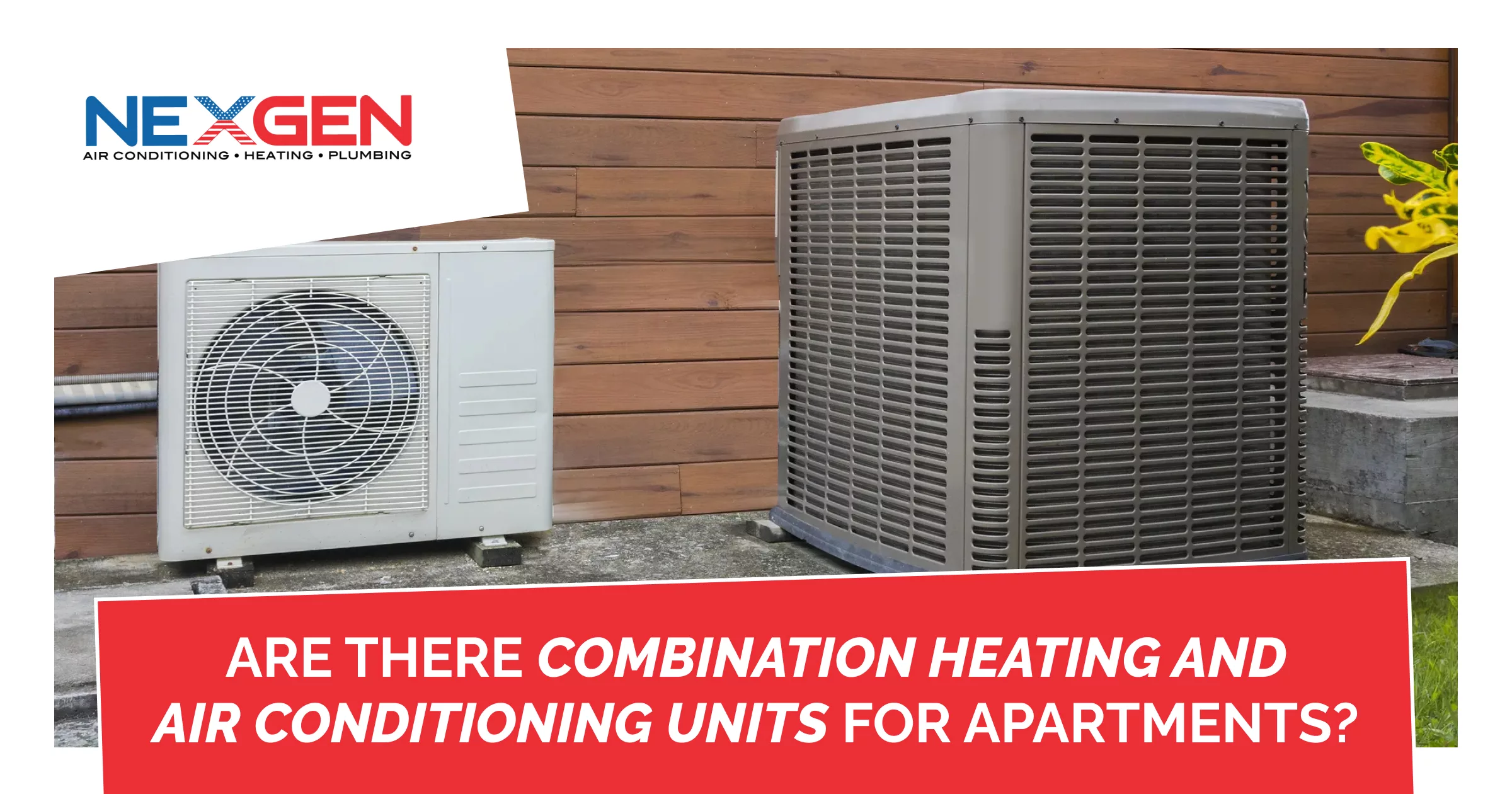
Apartment dwellers often face heating and cooling challenges. Tight space and design constraints can create issues with air movement. A lack of windows doesn’t help either. Limited airflow not only reduces comfort but can also increase humidity, mold growth, and paint deterioration. However, these issues can be avoided by installing combination heating and air conditioning units for apartments.
What Combined Heating and AC Options Are There?
A building can be served by decentralized heating systems, each of which serves a specific area, or a central system. Central units control temperature, humidity, and airflow from a single source. They may have a split design with an outdoor cabinet containing the compressor and condenser, while the evaporator is contained in an indoor unit. Air handlers and furnaces are typically separate components as well.
Common Combination Heating and Air Conditioning Units for Apartments
These aren’t the only heating and cooling systems that can be used in apartments. The following alternatives can save space and provide efficient comfort:
Packaged Central AC
A packaged central unit contains the condenser, compressor, and evaporator in a single cabinet. The unit is typically installed outside (on the ground or the roof). A packaged system often contains electric heating coils or a natural gas furnace along with an air conditioner (a separate indoor furnace is not required). Air circulation is managed by air supply and return ducts that pass through the roof or an exterior wall.
Ductless Mini-Split System
A mini-split is a cooling and heating system that allows the temperature to be adjusted at a certain level for one room, and another level in a different room. An apartment often isn’t large enough for a central unit. While the condenser is installed outside the building, compact mini-split air handlers can provide heating or cooling in individual rooms or small apartments. Separate AC and heater components aren’t required.
Packaged Terminal Air Conditioners (PTACs)
Often installed below windows in hotels, PTACs are self-contained, ductless units. They can heat or cool small areas like hotel rooms, small one-bedroom apartments, and residential add-ons. A PTAC can provide electric heat or be a reverse-cycle heat pump. Either way, it’s a reliable solution and many units have advanced digital controls to make them simple to use.
Combination Heating/AC Considerations
Several HVAC options are available for small spaces. That means there are choices to make, not only on the type of system but also based on specific factors. Every building is different so it’s important to consider the following:
- Size: The unit will work efficiently only if it’s sized right for the apartment’s square footage. The layout of the building matters as well. Excessive capacity will cause the system to use more energy and be more costly to run. A lower-capacity system won’t provide enough heating or cooling; it will struggle to keep up and wear out more quickly.
- Installation Compatibility: To install central air conditioning, a building must have ductwork. Upgrading an old structure with ducts can be difficult and expensive. Combination ductless HVAC units avoid these issues.
- Zoning: Combination systems can be zoned to provide heating and cooling to separate apartments (preferred in multi-tenant residences) or divide larger apartments into areas where the temperature can be set to different occupants’ preferences.
And, as with any HVAC system, look for a warranty. It can save a lot of money especially if something breaks while the unit is still covered. The length of the warranty and what it covers depends on the unit and brand. Read the terms of the contract to know what parts are covered and if labor is included before you sign it.
Purchase Combination HVAC Units from NexGen
Proudly serving Southern California, NexGen offers ductless heating and cooling systems that are compact, versatile, and efficient. These include wall-mount heat pumps with impressive heating and cooling ranges. Our licensed technicians provide HVAC installation, repair, and maintenance services. By signing up for our X Protection Plan, you can receive discounts and priority service, while specials and financing options are available. To learn more about our offerings and combination heating and air conditioning units for apartments, call (833) 729-9735 today.
What Is an ARUF Air Handler?
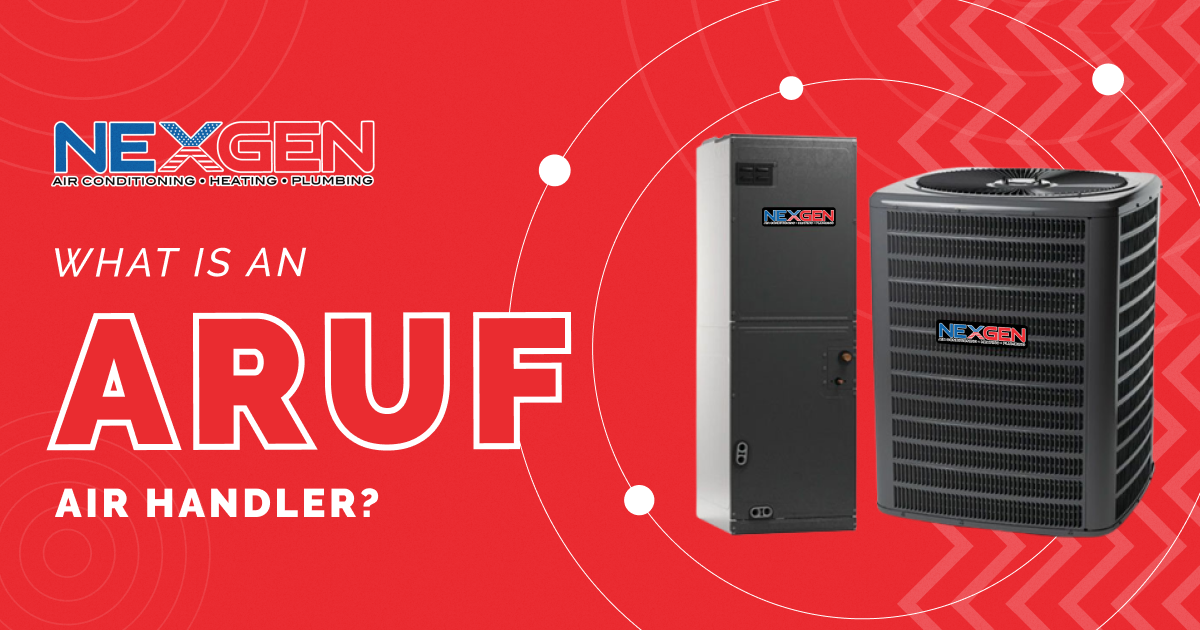
An ARUF air handler is one you’re likely to encounter when searching for an efficient, budget-friendly HVAC solution. At NexGen, the ARUF-Series Electric Air Handlers are extremely energy efficient thanks to an all-aluminum evaporator coil and multi-speed PSC blower motor. We’ll provide a more in-depth description of what this long-lasting indoor air conditioning unit does and why it’s preferred over similar solutions.
What Does ARUF Mean?
ARUF is a name designation for a series of air handlers. We also offer ASPT, AWUT, MBR, ACNF, and other series that offer various benefits. Most feature an all-aluminum coil that allows for highly efficient cooling and durability thanks to grooved tubing. There’s even a coil mounting track so the unit can be easily repositioned.
The air handler is certified by the Air-Conditioning, Heating, and Refrigeration Institute (AHRI) and ETL listed. It has also been tested by the American Society of Heating, Refrigeration, and Air-Conditioning Engineers (ASHRAE). When tested per ASHRAE Standard 193, it was found to have a cabinet air leakage of less than 2% at 1.0 inch H2O.
Other Benefits of an ARUF Air Handler
- Compact Size: The depth of the electric unit is 21 inches, so accessing it via an attic, for example, is much easier than larger units. This simplifies routine maintenance and professional service.
- Advanced Drain System: The unit’s thermoplastic pan is DecaBDE-free; this flame retardant was found to be a risk to the environment and human health. In addition, secondary drain connections are included.
- Improved Refrigerant Flow: The air handler has factory-mounted expansion valves; therefore, refrigerant flow is more precise and efficiency is improved.
- Improved Airflow: Multi-speed blower motors provide improvements in airflow while operating more efficiently; ARUF units maintain a SEER rating of up to 16.
- Compatibility: While being R-22 compatible, our ARUF air handler also works with R-410 chlorine-free refrigerant in heat pump applications. It is designed to meet the latest regulatory requirements.
A Full-Featured Cabinet with a Flexible Design
Available in 1½- to 5-ton sizes, the ARUF air handler is built into a cabinet that can be configured horizontally or vertically. A rigid SmartFrame™ provides improved lateral stability and allows for sturdy mounting of internal components. The blower casing is covered by foil-faced insulation that reduces operating noise and condensation. Screw-less sides and a rear panel also reduce condensation, especially when the unit is installed in a humid location. Better yet, no tools are needed to access the filter, making the unit easier to maintain.
The ARUF’s cabinet is as convenient as it is versatile. It’s available with 3 kW to 25 kW electric heater kits, which are field installed. A 10-Year Parts Lifetime Warranty is included, while members of our X Protection Family receive a lifetime replacement warranty.
Contact NexGen to Learn More
We will gladly answer your questions about the ARUF air handler and how it compares with our other industry-leading electric heating and cooling products. Traditional, rooftop and ductless systems are also available in Southern California as well as thermostats, air cleaners, and air purification systems. To learn more about our air-hander units and other HVAC options, or schedule a free estimate, call 833-729-9735 or book an appointment online.
How to Turn Off the Fresh Air Intake on an Air Conditioner
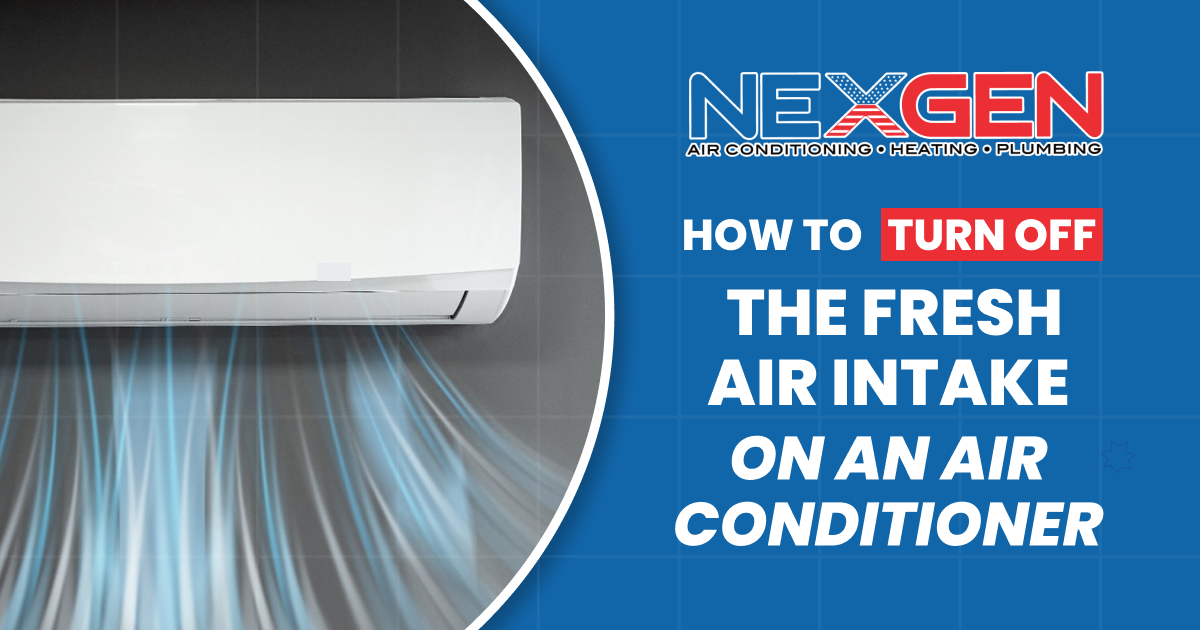
At NexGen, we lead the way in air conditioning and heating as well as indoor air quality services in Southern California. But with all the air quality testing and air purification system installations we handle, how you use your ACs intake is still important. Fresh air intakes help improve system performance and efficiency. But many people don’t know they can be opened and closed. Here, we’ll explain how to turn off the fresh air intake on an air conditioner.
Locate Your Fresh Air Intake
The air intake is typically an open duct that leads to a vent on a wall outside your home or the attic. There’s a small filter inside the vent so it can deliver clean air. This also lessens the demand on other HVAC filters. Depending on your home, it may have multiple fresh air intakes. The indoor side of an intake usually looks like a grilled vent. It’s often near furnaces or other gas appliances.
Closing A Fresh Air Damper
A damper is a device that allows, blocks, and/or adjusts the flow of air. It typically contains a frame and a blade that moves in and out of the frame using a spring-loaded mechanism. Some dampers can be adjusted in increments to manage the amount of air entering a building. There are different types of dampers, including:
- Control Dampers: Feature blades that fully open or close to regulate airflow and pressure in an AC or boiler system.
- Blade Dampers: Regulate airflow inside an air conditioning system to reduce noise and vibration.
- Balancing Dampers: Located inside ductwork, these regulate the amount of hot and cold air that flows into a room.
To close the damper in your air intake, and block the supply of outside air, follow the system’s owner’s manual. It may require:
- Sliding the dampers manually into a closed position.
- Turning off a fan switch if the intake is fan-operated.
- Using the HVAC control panel to automatically close the damper.
- Turning the lever or knob on an outdoor or indoor unit that says “fresh” or “air intake”.
If manually operating the damper, slide the damper cover over the opening. Do not use a rag, curtain, or article of clothing to block it. You could end up causing damage.
Should I Turn Off My Fresh Air Intake?
Fresh air can prevent the unit from overheating. It also improves circulation which helps your AC remove heat and humidity. Closing the damper forces the air conditioner to redirect air, which can have a variety of effects. But it may be the best option if there is a wildfire or other type of fire nearby, as this prevents smoke, particles, and toxins from getting into your home. Close all windows, doors, and other openings as well.
In addition to blocking harmful substances, turning off the fresh air intake at the right time can:
- Reduce wear and tear on components.
- Save on the cost of repairs.
- Increase system longevity.
But in general, opening both the dampers and vents will help your HVAC system reach the desired temperature more quickly and consume less energy, especially in colder outdoor temperatures.
Contact NexGen to Learn More
NexGen provides heating and air conditioning installation, repair, and maintenance throughout Southern California. We offer duct cleaning and other air quality services as well. If you have additional questions on how to turn off the fresh air intake on an air conditioner or wish to schedule service, book an appointment online or call 833-729-9735 now.
Do Mini Splits Purify the Air in Your Home?
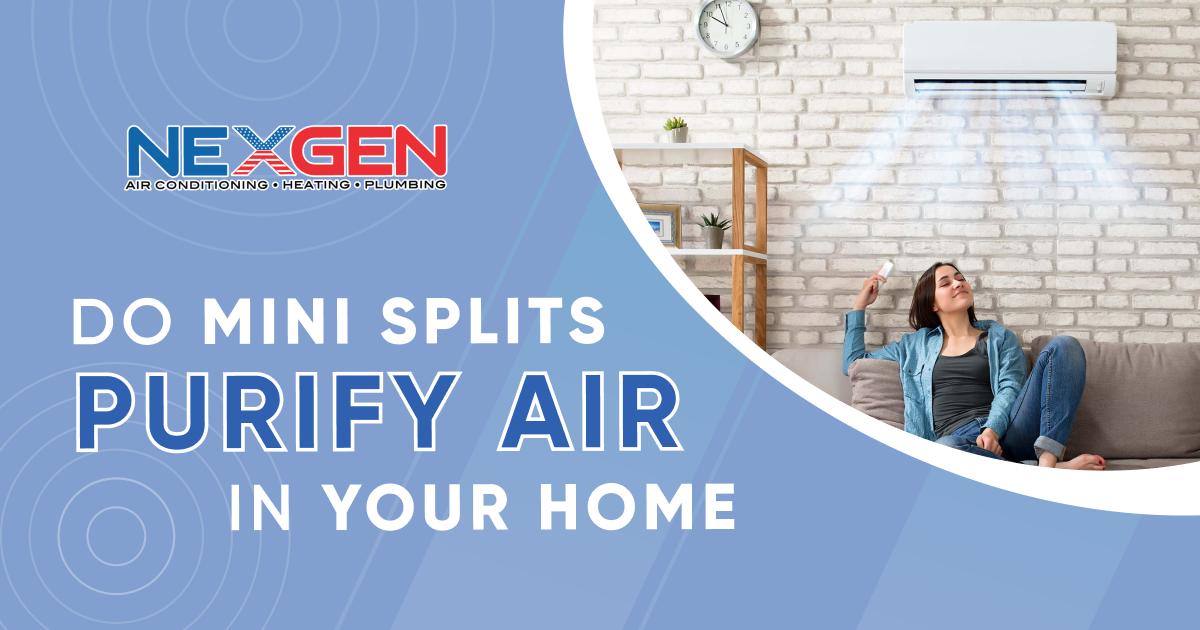
Unlike a central air conditioner, a mini-split system does not have ductwork, which can contribute to indoor air quality (IAQ) concerns. It consists of an outdoor unit and indoor air handlers. A refrigerant passes through the system to absorb heat so the system can provide heating or cooling. So, how do mini splits purify the air if they don’t use ductwork to circulate it around your home?
Why Install a Mini-Split System
Mini-splits can be installed in structures where it’s not possible to install ductwork. Other advantages include setting each room to a different temperature, establishing zoning for occupants with additional heating or cooling needs, and shutting off indoor units in unoccupied rooms to save energy.
Improved IAQ is also a significant benefit many people don’t know about. Ductless mini-splits are quite effective at keeping indoor air safe and clean. They can help decrease allergies, discomfort, and the risk of asthma and other illnesses.
How Mini-Splits Help Improve Indoor Air Quality
Ducted systems are notorious for efficiency issues and intrusion of contaminants like dust, dirt, bacteria, mold, chemicals, organic matter, and other materials that can decrease indoor air quality. A ductless mini-split avoids these problems with the following:
- No Ductwork: It’s less likely for a ductless system to collect pollutants and then recirculate them. Since there are no ducts, leakage of conditioned air, broken ducts and cracks or gaps where particles can enter are not a concern. This reduces the risk of breathing in contaminants.
- High-Quality Filters: A built-in filter allows each indoor air handler to remove dust, dirt, pet dander, debris, mold spores, allergens, and even bacteria. Alternative filters may be available, including anti-allergy enzyme filters, antimicrobial filters, and active carbon filters that trap microscopic airborne particles. NexGen provides a wide range of air quality solutions depending on your needs and concerns.
- Dehumidifiers: Mini-splits also dehumidify the air, whether running in heating or cooling mode. Some have a dry mode independent of cooling. Removing moisture from the air helps prevent mold and mildew growth, especially in dark, damp areas like bathrooms and basements. This can prevent musky smells and some allergy symptoms.
- Improved Efficiency: Mini-split filters remove more contaminants and allow for more efficient airflow. Multi-speed motors automatically adjust to demand. Traditional ACs turn off or run at full blast, but mini-splits can operate at different levels and have high SEER and HSPF ratings. Conditioned air is distributed directly, so both efficiency and air quality improvements are realized.
- Flexible Installation: Installed on a wall, ceiling, or above the floor, air handlers can be placed to optimize airflow and accessibility. They’re easier to clean and maintain as well. This makes it less likely you’ll neglect maintenance that includes cleaning filters and checking the unit for dirt, thereby resulting in cleaner air. The filter should be removed and wiped clean every four to six weeks.
- UV Lamps: An ultraviolet lamp can be integrated into mini-split systems to destroy most microorganisms, including bacteria, viruses, and mold. It can also help reduce maintenance requirements and allow your system to run more efficiently.
Install Mini-Splits That Purify the Air In Your Home
NexGen specializes in the installation, repair, and maintenance of ductless heating and cooling systems in Southern California. We provide a range of air quality services as well. Our goal is to ensure the comfort, efficiency, and safety of our client's homes. To learn more, book your service online or call 833-729-9735 today.
- Cover electrical sockets with plugs or seals.
- Place a fan near an open window when you see or smell smoke.
- Apply weatherstripping to windows to block outdoor smoke.
- Use a door sweep or draft guard to block smoke from outside.
Contact NexGen for Indoor Air Quality Solutions
NexGen can address air quality issues with a range of options. If cigarette smoke, mold, volatile organic compounds, carbon monoxide, or other pollutants are found in your home, we will help make air quality improvements. Air purification and filtration systems can be installed or we can help improve ventilation (duct cleaning, installing dehumidifiers, and furnace repair can help as well).
To learn more about our indoor air quality services in Southern California and request service, call 833-729-9735 today.


















